Last updated: October 29, 2024
Any links on this page that lead to products on Amazon are affiliate links and I earn a commission if you make a purchase. Thanks in advance – I really appreciate it!
Have you ever noticed a horse walking oddly or seeming to favor one leg? This could be a case of equine lameness, an alteration in a horse’s gait usually resulting from pain or discomfort. This irregularity can stem from various causes, such as injuries, illnesses, or the strain from excessive work.
Lameness isn’t merely an inconvenience—it constitutes a serious health issue for your horse. Comprehending what equine lameness is and intervening promptly can be the deciding factor between a swift recovery and a protracted, potentially strenuous rehabilitation process.
As such, being attuned to the signs of lameness is of paramount importance for every horse owner. This guide aims to arm you with the knowledge necessary to detect these early signs, thus enabling immediate action and appropriate care. Let’s dive further into understanding equine lameness—after all; your vigilance can be instrumental in ensuring your horse’s health.
Understanding Lameness
Lameness, at its core, refers to an abnormality or impairment in a horse’s normal gait or movement, often due to pain or discomfort. Understanding the causes of lameness can be key to addressing the issue and ensuring your horse’s well-being.
Several factors can contribute to lameness in horses. First, injuries such as sprains, strains, fractures, or bruises can lead to pain and an uneven gait. Second, illnesses like infections, arthritis, or degenerative conditions can also cause lameness as they impact the horse’s joints and overall health.
Third, congenital defects, which are present at birth, can result in structural abnormalities that make the horse more prone to lameness. Lastly, overwork and stress play a significant role in the development of lameness.
Horses pushed beyond their limits or subjected to excessive training can suffer from fatigue and musculoskeletal damage, leading to discomfort and irregular movement. By being aware of these common causes, horse owners can better monitor and address potential lameness issues in their equine companions.
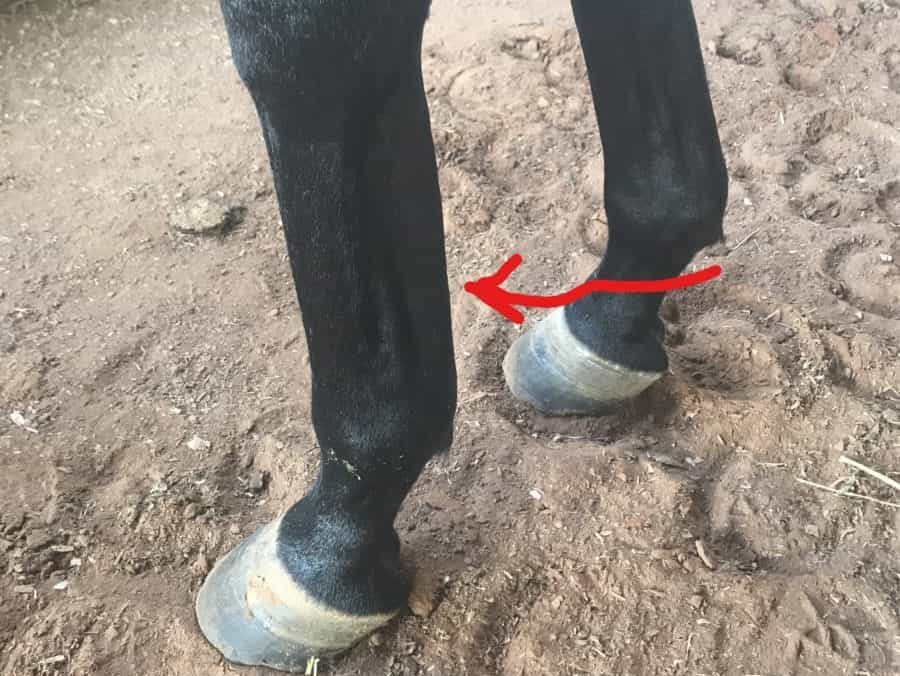
Recognizing Symptoms of Lameness
Detecting lameness in horses can be easier if you know what symptoms to look for. Visual signs often provide the first clue that something is amiss. For instance, an uneven or irregular gait might indicate that your horse is experiencing discomfort in one or more limbs.
Swelling or inflammation in the legs, hooves, or joints can also be a sign that there’s an underlying issue causing pain. Additionally, if you notice your horse favoring one leg over another, this could be a clear indication of lameness.
Aside from visual cues, behavioral changes can also signal a potential problem. A horse experiencing lameness may exhibit a sudden change in temperament, becoming irritable or more sensitive than usual. They may also show reluctance to move, perform, or engage in activities they once enjoyed, as these actions could be causing them discomfort.
Furthermore, a lame horse might struggle with lying down or standing up, as these actions can put additional stress on their affected limbs. By staying vigilant and recognizing these signs, horse owners can promptly address lameness and prevent it from worsening.
Subtle Signs of Lameness:
- changes in the way she usually goes forward
- difficulty turning,
- she is not paying attention
- changes lead incorrectly
- her body stays stiff
- pinning her ears,
- flaring nostrils
- intense staring, unusual blinking, or keeping her eyes closed
Obvious signs of Lameness
- reluctance to move in a small circle,
- head bob,
- shortened stride placement of the foot of the lame leg
- lack of flexion of the foot,
- asymmetrical hips
Identifying the Source of Lameness in a Horse.
When trying to determine the origin of the lameness, you need to perform a physical examination of the horse. Feel each limb, pick up each leg, flex all the joints, access the range of motion, and palpate all the tendons and ligaments.
Look at the horse’s muscle symmetry and overall muscle of the horse, and watch her in action. Start by watching her walk towards you and then away from you. Did you notice a bob of the horse’s head?
If so, try to determine which foot hits the ground when her head rises. She will drop her head and neck when the good foot hits the ground and raise her head when the unsound foot hits the ground.
Watch her travel on both hard and soft surfaces. Bone and joint problems are more noticeable on a hard surface, and soft tissue injuries are easier to discover on a pliable surface. Repeat this process at a jog. Look for both subtle and obvious signs of lameness.
Watch her jog while being led. Examine her move in a straight line and circles. To accomplish this, put her on a lunge line, and have her move in circles in both directions. (Click here to check Amazon prices for lunge lines) Do you notice she favors her inside leg?
Lunging will place more pressure on the inside leg and will pronounce the pain indicators making it easier to determine the source of lameness. Next, tack her up and watch how she moves under the saddle — watching the horse move while being ridden can disclose underlying pain or sign of lameness.
Sacroiliac pain is worse when ridden. If she only displays lameness when ridden, you need to examine her tack to ensure it’s appropriately fitted. Throughout this process, look for subtle and visible signs of lameness.
Once the general area has been identified as the source of pain, it will need to be isolated further. For example, if we identified she is favoring her left front leg, we have to determine if the pain is from the foot, tendon, muscle, joint, or a combination of more than one area. We have a couple of ways to accomplish this goal.
First is the manual method, which is my term for manipulating the injured limb to determine the pain site. Manual manipulation involves putting pressure on the muscle, checking for heat in the tendons, and flexing the joints.
One standard test is the flexion test. To perform the flexion test, extend the joint fully, and hold for a full minute. Upon release, encourage the horse to walk immediately. If she walks with a limp, she may have a joint abnormality.
The flexion test causes increased pain in the joints and exacerbates the lameness. Repeat this for each joint until you rule out all joints in the unsound leg. You can then examine the foot by putting pressure on the frog, soles, and hooves with hoof testers.
The horse should react when the testers hit a sensitive area (See Here for Amazon Pricing of hoof testers). A more advanced method to determine the source of the pain is nerve blocks. Nerve blocks are injections into an area believed to be the source of the pain.
If, after injection, the horse seems relieved of the pain, we know that we have identified one troubling area. At this point, we may need to perform further diagnostic testing. An MRI or X-ray can be used to further detail the damage’s extent.
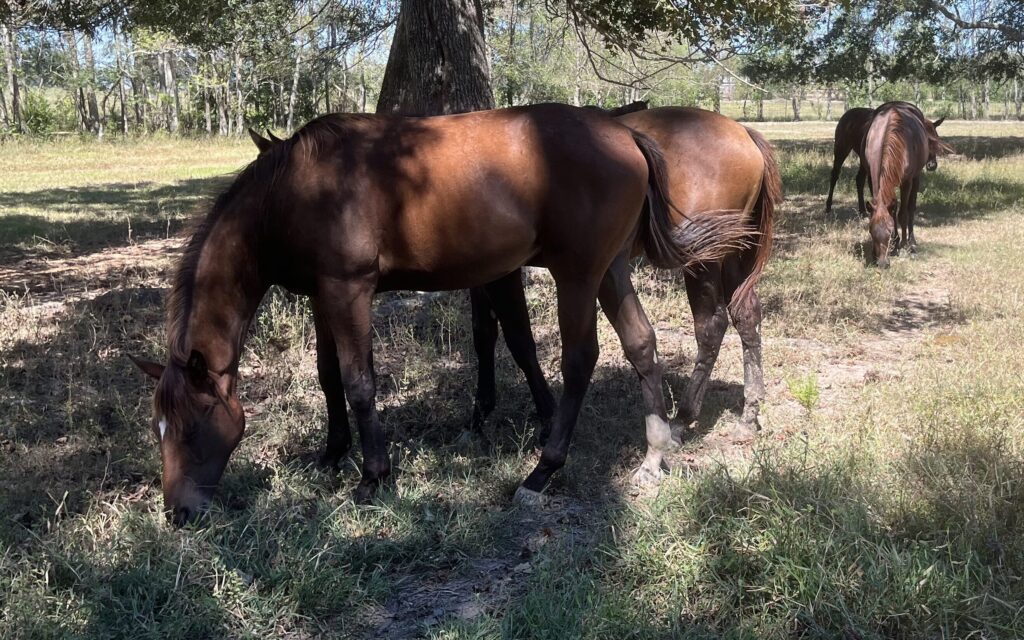
What Causes a Horse to Be Lame?
There are two categories when referring to causes of lameness: sudden onset lameness and subtle onset lameness.
Sudden Onset lameness
Sudden onset lameness can be particularly alarming for horse owners as it presents itself without warning and often manifests as a dramatic change in the horse’s movement and behavior. This type of lameness can be the result of various issues, such as acute injuries, infections, or exacerbation of underlying conditions, and typically causes the horse significant pain and distress.
For instance, a horse may suddenly become lame after stepping on a sharp object, causing a puncture wound in their hoof, or experiencing a traumatic event, like a fall or collision. In other cases, sudden lameness can emerge due to an underlying infection, such as a hoof abscess that reaches a critical point, or a joint issue like an acute arthritis flare-up.
In such situations, the horse may exhibit a markedly uneven gait or even refuse to bear weight on the affected limb. Additionally, they might display signs of distress, including restlessness, excessive sweating, or increased heart rate.
Due to the sudden and severe nature of this type of lameness, it’s crucial for horse owners to act quickly, thoroughly assess the situation, and consult a veterinarian to determine the appropriate course of action and alleviate the horse’s discomfort.
Subtle Onset lameness
Subtle onset lameness, in contrast to its sudden counterpart, can be a more insidious and challenging issue for horse owners to identify. This type of lameness develops gradually over time and may initially present with only mild or intermittent signs, making it difficult to detect without close observation.
Causes for subtle onset lameness can include chronic conditions, progressive wear, and tear, or repetitive strain injuries that slowly impact the horse’s gait and comfort. Examples of subtle onset lameness might include the slow progression of osteoarthritis, a common degenerative joint disease, or the development of navicular syndrome, which affects the horse’s heel and can cause ongoing pain.
In these cases, the horse may initially show only minor changes in gait or behavior, such as a slight stiffness or reduced willingness to perform specific tasks. As the condition worsens, the signs may become more pronounced and consistent, eventually leading to a more noticeable lameness.
Due to the elusive nature of subtle onset lameness, it’s essential for horse owners to pay close attention to their horse’s behavior, movement, and overall well-being. Regular check-ups and routine veterinary care can also help in identifying and addressing these issues before they progress to more severe problems.
Early intervention and management can be crucial in minimizing the impact of subtle onset lameness on the horse’s quality of life and performance.
Foot Lameness in Horses
Front foot pain is a primary cause of lameness in performance horses. This discomfort can stem from various factors; however, it is primarily due to the increased weight and pressure exerted on the front end of these equine athletes.
As performance horses engage in demanding activities, such as jumping, racing, or dressage, the added stress on their front limbs can contribute to a higher risk of injury and discomfort, potentially leading to lameness.
By understanding the unique challenges faced by performance horses, owners and trainers can implement targeted care and management strategies to minimize front foot pain and promote overall well-being.
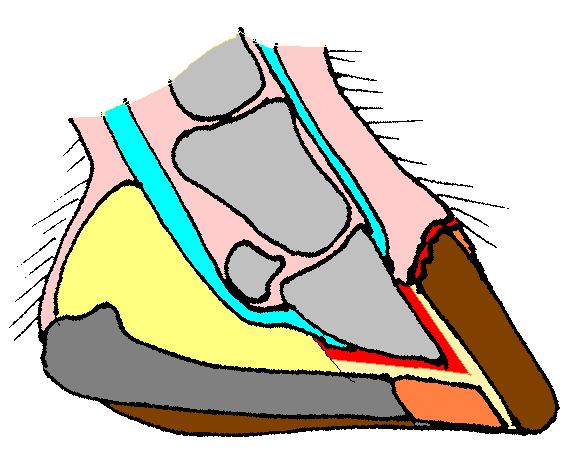
Abscess
An abscess is an infection in the foot. It is typically caused by bacteria entering the hoof. It is a common problem and can show up on your horse quickly. The symptoms may be severe, but the prognosis is for full and fast recovery with proper treatment.
Bruise
A bruise is swelling in the sole area. The injury can result from the horse having very soft feet or stepping on hard objects. It’s analogous to humans having a foot bruise. However, it can lead to an abscess if bacteria get into the bruised area.
Founder
Founder is technically referred to as laminitis. It is an inflammation of the laminae (folds of tissue connecting the pedal bone to the hoof). It can lead to the necessity of euthanization.
Founder is a common forelimb foot disease that causes pressure on the hoof wall and bone displacement. The pain is severe, and you can typically feel the hoof’s pulse and cause pain by applying pressure to the sole.
Coffin bone fracture
The coffin bone or pedal bone can be broken by a jump or misstep while running hard. The coffin bone is similar to our middle finger, but theirs extends into the tip of the hoof. With treatment and some time off, the bone can heal, and the horse returns to its normal activities.
Coffin joint inflammation
Coffin-joint inflammation may show as soft swelling above the coronary band on either side of the extensor tendon running down the center of the pastern. The swelling is caused by increased fluid in the joint capsule.
Coffin bone inflammation
Coffin bone inflammation and degradation, sometimes referred to as Pedal Osteitis, is the demineralization of the lower edge of the pedal bone. If caught early, full recovery is possible; if not, it can be irreversible. The symptoms are similar to navicular disease or coffin bone fracture.
Tendon or ligament swelling and inflammation
Tendon injuries in the foot occur most often within the hoof capsule and the sheath around the tendon. Ligaments attach to the many bones in the foot. Tendons course throughout a horse’s leg and into its feet.
Deep digital flexor tendons stretch from a horse’s foreleg to its foot. In the hind leg, the deep digital flexor tendon originates in the tibia and inserts into the coffin bone.
Ligament injuries can be mild to severe. With early detection and treatment, full recovery is possible.
Low ringbone
Low ringbone develops because of the stress put on the pastern and ligaments. It’s an arthritic condition in the coffin joint just within the top of the hoof wall. Low ringbone tends to be very painful because any swelling or enlargement has little room to expand under the hoof wall, which adds pressure to the joint.
It can be treated with diet and proper shoeing if caught early enough. It is a difficult problem to detect in its early stages. High ringbone occurs in the lower pastern joint and can also cause lameness, but typically isn’t as severe as low ringbone.
Bursal inflammation
Bursal inflammation or cartilage injury- Bursa is a sack filled with fluid that provides lubrication to muscles, skin, or ligaments. Bursal inflammation is a swelling of the bursa, also referred to as bursitis.
It can be caused by trauma or stress. If left untreated, it can lead to long-term problems, including infections.
Navicular syndrome
Navicular syndrome is a group of problems associated with the navicular bone. The cause is not known, and the navicular syndrome is rarely cured. The navicular bone is a flat bone that lays across the back of the coffin joint and is attached to the pedal bone with a ligament.
Once the condition in the foot has been identified, then a treatment plan needs to be started. Usually, the treatment will include a combination of therapies. A critical starting point is ensuring proper feet balance with good trimming and shoeing.
As you can see, a lot can go wrong with a horse foot.
Treatment Options for Lameness in the Foot.
Proper shoeing
The right foot care begins with proper trimming and shoeing. The goal is to provide side-to-side stability, decrease the toe’s length to ease break over, and provide adequate heel support.
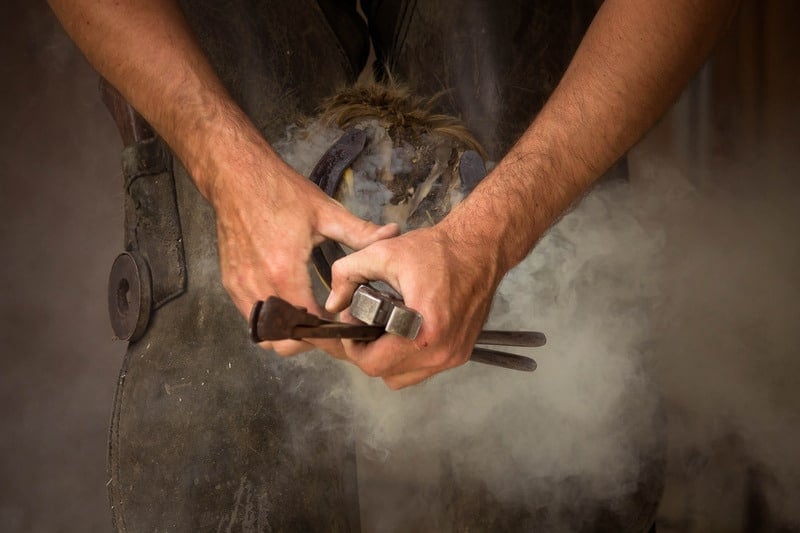
The support will decrease the tendon tension in the heel area. Less resistance at the toe equals less hoof wall stress and heel pain. A farrier may use therapeutic shoes in conjunction with the proper trimming to change the hoof’s angle and promote healing.
Pain medication
The most commonly used pain medication is “Bute”(Phenylbutazone). “Bute” also has anti-inflammatory properties to assist in the healing process. Although not the only medication used for pain and inflammation, it is the most common. “Bute” is useful for treating foot lameness when combined with other therapies.
Intra-joint treatments
Steroid injections are the same treatment used on humans. Shooting cortisone into a joint to relieve pain. In a horse, the veterinarian will often use cortisone in combination with hyaluronic acid. The cortisone will rapidly decrease joint inflammation, and the hyaluronic acid will help with the lubrication of joint edges and assist in rebuilding joint fluid.
Shockwave Therapy
Shockwave Therapy has been successful with some horses and not others. Its effectiveness is controversial and not often used.
Systemic joint medications
Systemic joint medications are designed to treat generalized joint inflammation and to help maintain soundness. They have limited benefits if the problem involves tendons, ligaments, and hoof balance.
Surgery
The final option is surgery for horses not responding to other treatments. The type of surgery and the likelihood of recovery depend on the cause of lameness. I wrote a detailed article on equine leg injuries and why it’s often necessary to euthanize horses when they break a leg.
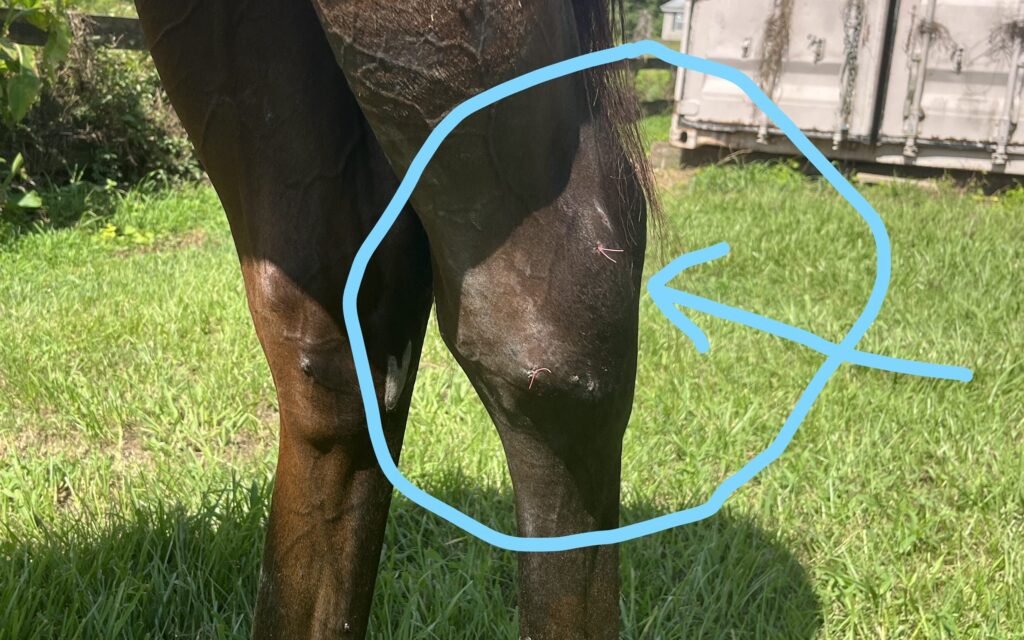
Other Causes of Lameness in Horses
As we know, foot disease is the leading cause of lameness in a horse, but it is not the only cause.
Tendon lameness
Tendon lameness can be caused by overstretching of tendons that can damage the fibers in the cord. The damage can range from very minor to significant tears or even rupture. If caught early enough, it can be treated with rest.
This injury will display heat in the damaged region. Bowed tendons are tears of the superficial digital flexor tendon in the middle of the cannon bone region. These tears cause a curved, bow-like swelling on the back of the leg between the knee and the ankle.
Bone spavin
Bone spavin is an inflammation of the hock. It is the most common hind leg lameness, and it’s treated with injection into the hock joint. Tenosynovitis is also a cause of lameness involving the hock area.
Osselets
Osselets are inflammation and swelling in the fetlock joint. It likely is caused by overworking the joint. Heat is often present in the joint.
Stifle lameness
Stifle lameness is a common condition in the hind leg. The stifle joint is the largest joint in the horse and is similar to the human knee. And like our knee can have the same problems. Meniscus tears, joint instability, and arthritis.
Knee lameness
The knee on a horse is complex. It can be damaged for various reasons, including conformation irregularity, repetitive use, and traumatic impact. Most damage to the knee can be recognized by radiating heat in the affected area.
If knee damage is left untreated, it could lead to arthritis. Chip fractures can be treated with surgery and are often successful.
Back pain
Back pain is usually secondary to lameness in a leg and is caused by compensating for the pain by unnaturally twisting the back. Once the primary source of pain is removed, the back pain will also be relieved.
Pelvic lameness
Pelvic lameness is not common; however, it can occur from a traumatic event. A fall can damage ligaments in the pelvic area leading to a horse being unable to walk correctly. If the injury to the pelvic area is diagnosed, early full recovery is expected.
A horse’s body is complex, and many things can disrupt a horse’s gait. We looked at some of the causes and will now turn to the rehabilitation process.
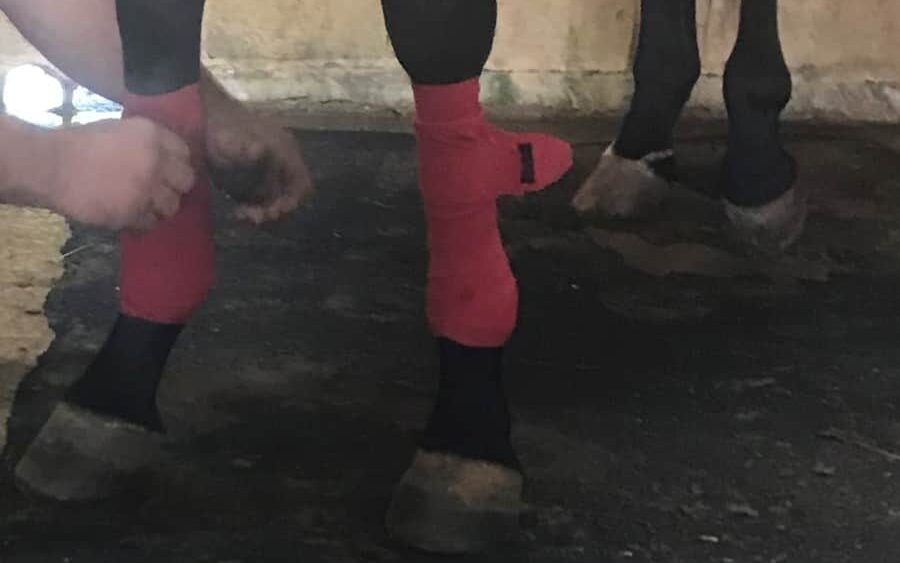
Preventative Measures
Preventative measures are crucial in maintaining your horse’s overall health and reducing the risk of lameness. Proper horse care starts with regular hoof care, which includes frequent inspections, cleaning, and trimming to maintain optimal hoof health.
A balanced diet and exercise routine are also important, ensuring that your horse receives the right nutrients and stays in good physical shape to reduce the likelihood of injuries. Additionally, providing adequate rest and recovery time allows your horse to recuperate from strenuous activities and helps prevent overwork-related lameness.
In addition, polo wraps can help prevent horse lameness by supporting tendons during exercise. However, they must be applied correctly to avoid uneven pressure. While beneficial, they’re not a substitute for overall good horse care, including regular exercise and proper hoof care, which are key in preventing lameness.
Treatment Options
When it comes to treating lame horses, the appropriate course of action depends on the underlying cause and severity of the condition. Rest and rehabilitation are often the first steps, allowing the horse’s body to heal naturally and regain its strength.
Pain management and medications, such as anti-inflammatory drugs, can help alleviate discomfort and reduce inflammation. In some cases, physical therapy may be necessary to restore function and mobility in the affected limbs.
Finally, if conservative treatments prove unsuccessful, surgical intervention may be required to address more severe issues like fractures, joint problems, or other structural abnormalities. By combining preventative measures with appropriate treatments, horse owners can effectively manage lameness and ensure the long-term well-being of their equine companions.
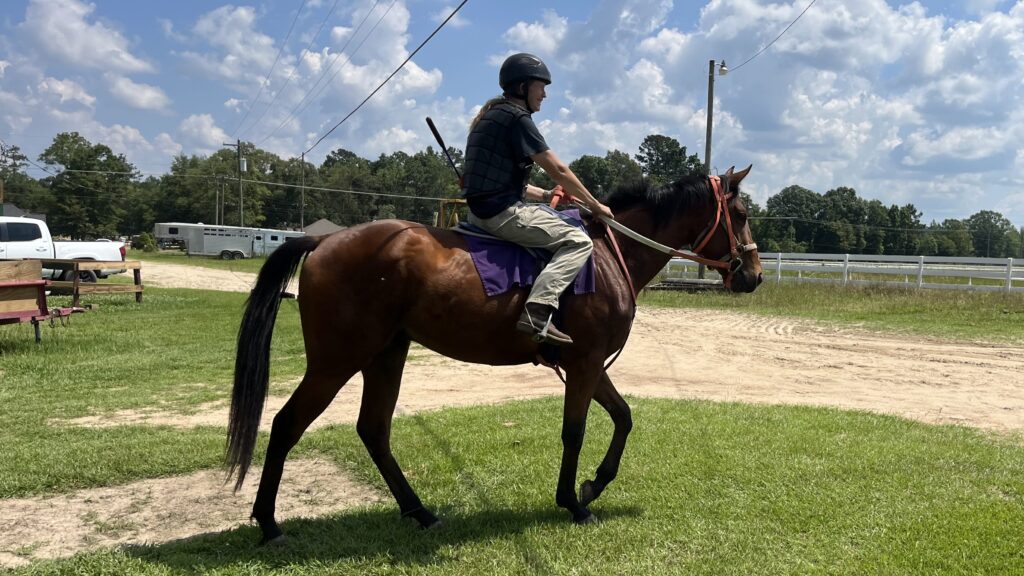
Rehabilitation of a tendon injury.
A veterinarian should design a targeted physiotherapy plan to address your horse’s lameness. Some programs may include massage, equine chiropractic care, acupuncture, joint mobilization, and activation exercise.
After a tendon injury occurs, it is important to ice the affected area or run cold water over it. Next, wrap the leg and give an initial treatment of nonsteroidal anti-inflammatory drugs. (Check Amazon for prices on leg wraps here) Contact the veterinarian and try to determine the severity of the tendon damage.
Often your horse should get stall rest, and its exercise is limited for at least two months. During this time, run cold water over the tendon and wrap the leg with polo wraps. During periods outside of the stall, she should be kept on a lead rope.
Two months of treatment should allow the tendon to heal and prevent any injury recurrence. The topical application of DMSO may help decrease residual swelling in the leg. Ultrasounds of the tendon are warranted every sixty days to evaluate the progress of the injured tendon.
Once the leg begins to improve, you can introduce jogging and allow the horse into a small paddock to move around independently. Check here for asymmetry, atrophy, and abnormal development. Look for swelling, heat, or lumps and bumps. Increase exercise gradually over the next couple of months.
Eventually, she will be able to go through an hour of activity, with 30 to 35 minutes of trotting and five minutes of galloping. You should continue ultrasound exams to monitor the progress of the tendon, along with full lameness examinations.
The plan is to move the horse to full recovery without causing any setbacks. Ligaments are fragile and can be reinjured easily. Monitoring progress with the ultrasound and palpating the leg will help prevent recovery delays.
There are several other techniques used today to heal tendons. However, none have been universally accepted. These include pin firing, stem cell, plasma therapy, tendon splitting, electromagnetic, and low-power laser treatment are just some of the methods.
Your veterinarian is the best source to determine the best plan for your horse. Although tendon injuries are a severe lameness source, they can be successfully treated, just like most other sources of lameness.
However, the horse will need time to heal and return to his pre-injury condition. Be patient, monitor your horse, and realize you can’t eliminate some types of pain.
Conclusion
If you are ever in doubt about your horse’s health, it is always best to consult with a veterinarian. Early detection of lameness can prevent further damage and help get your horse back to being his healthy self. Have you ever had to deal with a lame horse? What tips do you have for others who may find themselves in this situation?
FAQ
Can a lame horse recover?
It depends. Some horses with minor lameness may recover with rest and proper treatment, but others may have permanent damage and never fully regain their former soundness.
Can you ride a horse with slight lameness?
You shouldn’t ride a lame horse. Horses should be sound and able to carry a rider without any pain. If you are unsure whether or not your horse is sound, consult your veterinarian.
Can a horse be lame but not in pain?
Yes. A horse can be lame but not in pain. Horses may be lame for many reasons (e.g., injury, joint problems, muscle problems, etc.), and not all of these will cause them pain. For example, a horse may have ligament damage that restricts its movement but doesn’t cause any pain.

About the Author: Miles Henry
Lifelong Horseman | Racehorse Owner | Published Author
Miles Henry brings over 25 years of hands-on experience training and owning Thoroughbred racehorses. Raised with Quarter Horses and Appaloosas, he’s spent a lifetime learning from horses—on the track, in the barn, and in the field. Today, he runs a small but successful racing stable in Louisiana and shares real-world insights on HorseRacingSense.com, helping horse owners, fans, and bettors navigate the sport with confidence.
📚 Books: View Miles’s books on Amazon »
🎧 Podcast Guest: Animal Tales Ep. 32 |
YouTube Interview
📩 Newsletter: Sign up for racing tips and horse care advice »
🔗 Follow Miles:
Twitter |
Facebook |
YouTube



